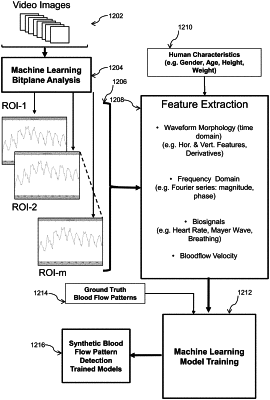| CPC G16H 10/60 (2018.01) [A61B 5/0261 (2013.01); A61B 5/7267 (2013.01); G06N 20/00 (2019.01); G06V 10/431 (2022.01); G06V 10/774 (2022.01); G06V 10/82 (2022.01); G06V 20/95 (2022.01); G06V 40/161 (2022.01); G06V 40/172 (2022.01); G06V 40/40 (2022.01); G16H 30/40 (2018.01); G06V 40/15 (2022.01)] | 20 Claims |

|
1. A method for detection of synthesized videos of humans, the method executed on one or more processors, the method comprising:
receiving a video comprising a captured image sequence of light re-emitted from the skin of a human subject;
determining blood flow signals using a first machine learning model trained with a hemoglobin concentration (HC) changes training set, the first machine learning model taking as input bit values from a set of bitplanes in the captured image sequence, the HC changes training set comprising bit values from each bitplane of images captured from a set of subjects for which HC changes are known;
determining whether blood flow patterns from the video are indicative of a synthesized video using a second machine learning model, the second machine learning model taking as input the blood flow signals, the second machine learning model trained using a blood flow training set comprising blood flow data signals from at least one of a plurality of videos of other human subjects for which it is known whether each video is synthesized; and
outputting the determination of whether the blood flow patterns from the video are indicative of a synthesized video.
|